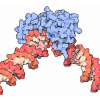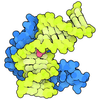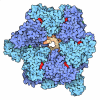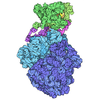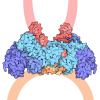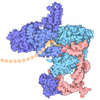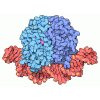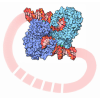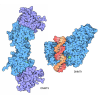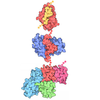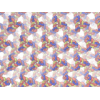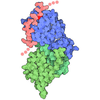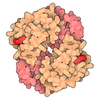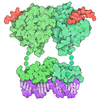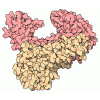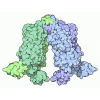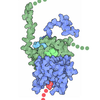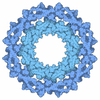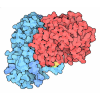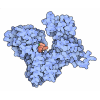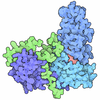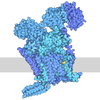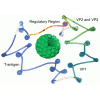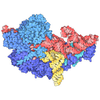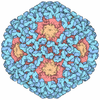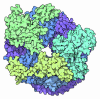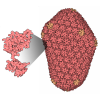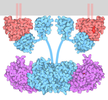[English] 日本語
 Yorodumi
Yorodumi- PDB-9ipu: cryo-EM structure of the RNF168(1-193)/UbcH5c-Ub ubiquitylation m... -
+ Open data
Open data
- Basic information
Basic information
| Entry | Database: PDB / ID: 9ipu | |||||||||||||||||||||||||||||||||||||||||||||
|---|---|---|---|---|---|---|---|---|---|---|---|---|---|---|---|---|---|---|---|---|---|---|---|---|---|---|---|---|---|---|---|---|---|---|---|---|---|---|---|---|---|---|---|---|---|---|
| Title | cryo-EM structure of the RNF168(1-193)/UbcH5c-Ub ubiquitylation module bound to H1.0-K63-Ub3 modified chromatosome | |||||||||||||||||||||||||||||||||||||||||||||
 Components Components |
| |||||||||||||||||||||||||||||||||||||||||||||
 Keywords Keywords | NUCLEAR PROTEIN / RNF168 / H1.0 / ubiquitylation / nucleosome / chromatosome | |||||||||||||||||||||||||||||||||||||||||||||
| Function / homology |  Function and homology information Function and homology informationhistone H2AK15 ubiquitin ligase activity / positive regulation of transcription regulatory region DNA binding / histone ubiquitin ligase activity / Signaling by BMP / negative regulation of DNA recombination / protein K6-linked ubiquitination / (E3-independent) E2 ubiquitin-conjugating enzyme / Apoptosis induced DNA fragmentation / double-strand break repair via classical nonhomologous end joining / isotype switching ...histone H2AK15 ubiquitin ligase activity / positive regulation of transcription regulatory region DNA binding / histone ubiquitin ligase activity / Signaling by BMP / negative regulation of DNA recombination / protein K6-linked ubiquitination / (E3-independent) E2 ubiquitin-conjugating enzyme / Apoptosis induced DNA fragmentation / double-strand break repair via classical nonhomologous end joining / isotype switching / protein K11-linked ubiquitination / chromosome condensation / positive regulation of protein targeting to mitochondrion / nucleosomal DNA binding / Formation of the ternary complex, and subsequently, the 43S complex / K63-linked polyubiquitin modification-dependent protein binding / E2 ubiquitin-conjugating enzyme / Formation of Senescence-Associated Heterochromatin Foci (SAHF) / response to ionizing radiation / Ribosomal scanning and start codon recognition / Translation initiation complex formation / DNA repair-dependent chromatin remodeling / minor groove of adenine-thymine-rich DNA binding / SARS-CoV-1 modulates host translation machinery / ubiquitin conjugating enzyme activity / Peptide chain elongation / Selenocysteine synthesis / Formation of a pool of free 40S subunits / negative regulation of transcription elongation by RNA polymerase II / Eukaryotic Translation Termination / SRP-dependent cotranslational protein targeting to membrane / Response of EIF2AK4 (GCN2) to amino acid deficiency / Viral mRNA Translation / protein K63-linked ubiquitination / Nonsense Mediated Decay (NMD) independent of the Exon Junction Complex (EJC) / protein monoubiquitination / negative regulation of BMP signaling pathway / GTP hydrolysis and joining of the 60S ribosomal subunit / ubiquitin ligase complex / L13a-mediated translational silencing of Ceruloplasmin expression / Major pathway of rRNA processing in the nucleolus and cytosol / interstrand cross-link repair / protein K48-linked ubiquitination / SUMOylation of DNA damage response and repair proteins / Nonsense Mediated Decay (NMD) enhanced by the Exon Junction Complex (EJC) / negative regulation of megakaryocyte differentiation / protein autoubiquitination / protein localization to CENP-A containing chromatin / nucleosome binding / Chromatin modifying enzymes / Replacement of protamines by nucleosomes in the male pronucleus / CENP-A containing nucleosome / Packaging Of Telomere Ends / Maturation of protein E / Maturation of protein E / ER Quality Control Compartment (ERQC) / Myoclonic epilepsy of Lafora / transcription repressor complex / FLT3 signaling by CBL mutants / Recognition and association of DNA glycosylase with site containing an affected purine / Cleavage of the damaged purine / Prevention of phagosomal-lysosomal fusion / IRAK2 mediated activation of TAK1 complex / Alpha-protein kinase 1 signaling pathway / Glycogen synthesis / IRAK1 recruits IKK complex / IRAK1 recruits IKK complex upon TLR7/8 or 9 stimulation / Endosomal Sorting Complex Required For Transport (ESCRT) / Membrane binding and targetting of GAG proteins / Negative regulation of FLT3 / Regulation of TBK1, IKKε (IKBKE)-mediated activation of IRF3, IRF7 / PTK6 Regulates RTKs and Their Effectors AKT1 and DOK1 / Regulation of TBK1, IKKε-mediated activation of IRF3, IRF7 upon TLR3 ligation / Constitutive Signaling by NOTCH1 HD Domain Mutants / IRAK2 mediated activation of TAK1 complex upon TLR7/8 or 9 stimulation / cytosolic ribosome / NOTCH2 Activation and Transmission of Signal to the Nucleus / TICAM1,TRAF6-dependent induction of TAK1 complex / Deposition of new CENPA-containing nucleosomes at the centromere / TICAM1-dependent activation of IRF3/IRF7 / APC/C:Cdc20 mediated degradation of Cyclin B / Downregulation of ERBB4 signaling / Regulation of FZD by ubiquitination / Recognition and association of DNA glycosylase with site containing an affected pyrimidine / Cleavage of the damaged pyrimidine / APC-Cdc20 mediated degradation of Nek2A / p75NTR recruits signalling complexes / telomere organization / InlA-mediated entry of Listeria monocytogenes into host cells / TRAF6 mediated IRF7 activation in TLR7/8 or 9 signaling / TRAF6-mediated induction of TAK1 complex within TLR4 complex / Regulation of pyruvate metabolism / NF-kB is activated and signals survival / Interleukin-7 signaling / Regulation of innate immune responses to cytosolic DNA / Pexophagy / Downregulation of ERBB2:ERBB3 signaling / RNA Polymerase I Promoter Opening / NRIF signals cell death from the nucleus / Inhibition of DNA recombination at telomere Similarity search - Function | |||||||||||||||||||||||||||||||||||||||||||||
| Biological species |  Homo sapiens (human) Homo sapiens (human) | |||||||||||||||||||||||||||||||||||||||||||||
| Method | ELECTRON MICROSCOPY / single particle reconstruction / cryo EM / Resolution: 4.3 Å | |||||||||||||||||||||||||||||||||||||||||||||
 Authors Authors | Ai, H.S. / Deng, Z.H. / Liu, L. | |||||||||||||||||||||||||||||||||||||||||||||
| Funding support |  China, 1items China, 1items
| |||||||||||||||||||||||||||||||||||||||||||||
 Citation Citation |  Journal: Angew Chem Int Ed Engl / Year: 2025 Journal: Angew Chem Int Ed Engl / Year: 2025Title: Promotion of RNF168-Mediated Nucleosomal H2A Ubiquitylation by Structurally Defined K63-Polyubiquitylated Linker Histone H1. Authors: Qiang Shi / Zhiheng Deng / Liying Zhang / Zebin Tong / Jia-Bin Li / Guo-Chao Chu / Huasong Ai / Lei Liu /  Abstract: The chemical synthesis of histones with homogeneous modifications is a powerful approach for quantitatively deciphering the functional crosstalk between different post-translational modifications ...The chemical synthesis of histones with homogeneous modifications is a powerful approach for quantitatively deciphering the functional crosstalk between different post-translational modifications (PTMs). In this study, we developed an expedient site-specific (poly)ubiquitylation strategy (CAEPL, Cysteine Aminoethylation coupled with Enzymatic Protein Ligation), which integrates the Cys-aminoethylation reaction with the process of ubiquitin-activating enzyme UBA1-assisted native chemical ligation. Using this strategy, we successfully prepared monoubiquitylated and K63-linked di- and tri-ubiquitylated linker histone H1.0 proteins, which were incorporated into individual chromatosomes. Quantitative biochemical analysis of different RNF168 constructs on H1 ubiquitylated chromatosomes with different ubiquitin chain lengths demonstrated that K63-linked polyubiquitylated H1.0 could directly stimulate RNF168 ubiquitylation activity by enhancing the affinity between RNF168 and the chromatosome. Subsequent cryo-EM structural analysis of the RNF168/UbcH5c-Ub/H1.0-K63-Ub chromatosome complex revealed the potential recruitment orientation between RNF168 UDM1 domain and K63-linked ubiquitin chain on H1.0. Finally, we explored the impact of H1.0 ubiquitylation on RNF168 activity in the context of asymmetric H1.0-K63-Ub di-nucleosome substrate, revealing a comparable stimulation effect of both the inter- and intra-nucleosomal crosstalk. Overall, our study highlights the significance of access to structurally defined polyubiquitylated H1.0 by the CAEPL strategy, enabling in-depth mechanistic investigations of in-trans PTM crosstalk between linker histone H1.0 and core histone H2A ubiquitylation. | |||||||||||||||||||||||||||||||||||||||||||||
| History |
|
- Structure visualization
Structure visualization
| Structure viewer | Molecule:  Molmil Molmil Jmol/JSmol Jmol/JSmol |
|---|
- Downloads & links
Downloads & links
- Download
Download
| PDBx/mmCIF format |  9ipu.cif.gz 9ipu.cif.gz | 597.1 KB | Display |  PDBx/mmCIF format PDBx/mmCIF format |
|---|---|---|---|---|
| PDB format |  pdb9ipu.ent.gz pdb9ipu.ent.gz | 472.1 KB | Display |  PDB format PDB format |
| PDBx/mmJSON format |  9ipu.json.gz 9ipu.json.gz | Tree view |  PDBx/mmJSON format PDBx/mmJSON format | |
| Others |  Other downloads Other downloads |
-Validation report
| Arichive directory |  https://data.pdbj.org/pub/pdb/validation_reports/ip/9ipu https://data.pdbj.org/pub/pdb/validation_reports/ip/9ipu ftp://data.pdbj.org/pub/pdb/validation_reports/ip/9ipu ftp://data.pdbj.org/pub/pdb/validation_reports/ip/9ipu | HTTPS FTP |
|---|
-Related structure data
| Related structure data |  60781MC M: map data used to model this data C: citing same article ( |
|---|---|
| Similar structure data | Similarity search - Function & homology  F&H Search F&H Search |
- Links
Links
- Assembly
Assembly
| Deposited unit | 
|
|---|---|
| 1 |
|
- Components
Components
-Protein , 8 types, 12 molecules IAEBFCGDHKLM
| #1: Protein | Mass: 20901.145 Da / Num. of mol.: 1 Source method: isolated from a genetically manipulated source Source: (gene. exp.)  Homo sapiens (human) / Gene: H1-0, H1F0, H1FV / Production host: Homo sapiens (human) / Gene: H1-0, H1F0, H1FV / Production host:  | ||||||||||||
|---|---|---|---|---|---|---|---|---|---|---|---|---|---|
| #2: Protein | Mass: 15273.838 Da / Num. of mol.: 2 Source method: isolated from a genetically manipulated source Source: (gene. exp.)  Homo sapiens (human) Homo sapiens (human)Gene: H3C15, HIST2H3A, H3C14, H3F2, H3FM, HIST2H3C, H3C13, HIST2H3D Production host:  #3: Protein | Mass: 11263.231 Da / Num. of mol.: 2 Source method: isolated from a genetically manipulated source Source: (gene. exp.)  Homo sapiens (human) Homo sapiens (human)Gene: H4C1, H4/A, H4FA, HIST1H4A, H4C2, H4/I, H4FI, HIST1H4B, H4C3, H4/G, H4FG, HIST1H4C, H4C4, H4/B, H4FB, HIST1H4D, H4C5, H4/J, H4FJ, HIST1H4E, H4C6, H4/C, H4FC, HIST1H4F, H4C8, H4/H, H4FH, ...Gene: H4C1, H4/A, H4FA, HIST1H4A, H4C2, H4/I, H4FI, HIST1H4B, H4C3, H4/G, H4FG, HIST1H4C, H4C4, H4/B, H4FB, HIST1H4D, H4C5, H4/J, H4FJ, HIST1H4E, H4C6, H4/C, H4FC, HIST1H4F, H4C8, H4/H, H4FH, HIST1H4H, H4C9, H4/M, H4FM, HIST1H4I, H4C11, H4/E, H4FE, HIST1H4J, H4C12, H4/D, H4FD, HIST1H4K, H4C13, H4/K, H4FK, HIST1H4L, H4C14, H4/N, H4F2, H4FN, HIST2H4, HIST2H4A, H4C15, H4/O, H4FO, HIST2H4B, H4C16, H4-16, HIST4H4 Production host:  #4: Protein | Mass: 14008.318 Da / Num. of mol.: 2 Source method: isolated from a genetically manipulated source Source: (gene. exp.)  Homo sapiens (human) / Gene: H2AC4, H2AFM, HIST1H2AB, H2AC8, H2AFA, HIST1H2AE / Production host: Homo sapiens (human) / Gene: H2AC4, H2AFM, HIST1H2AB, H2AC8, H2AFA, HIST1H2AE / Production host:  #5: Protein | Mass: 13790.018 Da / Num. of mol.: 2 Source method: isolated from a genetically manipulated source Source: (gene. exp.)  Homo sapiens (human) / Gene: H2BC12, H2BFT, HIRIP1, HIST1H2BK / Production host: Homo sapiens (human) / Gene: H2BC12, H2BFT, HIRIP1, HIST1H2BK / Production host:  #6: Protein | | Mass: 16657.938 Da / Num. of mol.: 1 Source method: isolated from a genetically manipulated source Source: (gene. exp.)  Homo sapiens (human) / Gene: UBE2D3, UBC5C, UBCH5C / Production host: Homo sapiens (human) / Gene: UBE2D3, UBC5C, UBCH5C / Production host:  References: UniProt: P61077, E2 ubiquitin-conjugating enzyme, (E3-independent) E2 ubiquitin-conjugating enzyme #7: Protein | | Mass: 22533.523 Da / Num. of mol.: 1 Source method: isolated from a genetically manipulated source Source: (gene. exp.)  Homo sapiens (human) / Gene: RNF168 / Production host: Homo sapiens (human) / Gene: RNF168 / Production host:  References: UniProt: Q8IYW5, RING-type E3 ubiquitin transferase #8: Protein | | Mass: 8519.778 Da / Num. of mol.: 1 Source method: isolated from a genetically manipulated source Source: (gene. exp.)  Homo sapiens (human) / Gene: RPS27A, UBA80, UBCEP1 / Production host: Homo sapiens (human) / Gene: RPS27A, UBA80, UBCEP1 / Production host:  |
-DNA chain , 2 types, 2 molecules JN
| #9: DNA chain | Mass: 52825.652 Da / Num. of mol.: 1 Source method: isolated from a genetically manipulated source Source: (gene. exp.)  Homo sapiens (human) / Production host: Homo sapiens (human) / Production host:  |
|---|---|
| #10: DNA chain | Mass: 52754.609 Da / Num. of mol.: 1 Source method: isolated from a genetically manipulated source Source: (gene. exp.)  Homo sapiens (human) / Production host: Homo sapiens (human) / Production host:  |
-Non-polymers , 1 types, 2 molecules 
| #11: Chemical |
|---|
-Details
| Has ligand of interest | Y |
|---|---|
| Has protein modification | N |
-Experimental details
-Experiment
| Experiment | Method: ELECTRON MICROSCOPY |
|---|---|
| EM experiment | Aggregation state: PARTICLE / 3D reconstruction method: single particle reconstruction |
- Sample preparation
Sample preparation
| Component | Name: cryo-EM structure of the RNF168(1-193)/UbcH5c-Ub ubiquitylation module bound to H1.0-K63-Ub3 modified chromatosome Type: COMPLEX / Entity ID: #1-#10 / Source: RECOMBINANT |
|---|---|
| Source (natural) | Organism:  Homo sapiens (human) Homo sapiens (human) |
| Source (recombinant) | Organism:  |
| Buffer solution | pH: 7.5 |
| Specimen | Embedding applied: NO / Shadowing applied: NO / Staining applied: NO / Vitrification applied: YES |
| Specimen support | Grid type: Quantifoil R1.2/1.3 |
| Vitrification | Cryogen name: ETHANE |
- Electron microscopy imaging
Electron microscopy imaging
| Experimental equipment |  Model: Titan Krios / Image courtesy: FEI Company |
|---|---|
| Microscopy | Model: FEI TITAN KRIOS |
| Electron gun | Electron source:  FIELD EMISSION GUN / Accelerating voltage: 300 kV / Illumination mode: FLOOD BEAM FIELD EMISSION GUN / Accelerating voltage: 300 kV / Illumination mode: FLOOD BEAM |
| Electron lens | Mode: BRIGHT FIELD / Nominal defocus max: 1800 nm / Nominal defocus min: 1000 nm |
| Image recording | Electron dose: 50 e/Å2 / Film or detector model: GATAN K3 (6k x 4k) |
- Processing
Processing
| EM software | Name: PHENIX / Category: model refinement | ||||||||||||||||||||||||
|---|---|---|---|---|---|---|---|---|---|---|---|---|---|---|---|---|---|---|---|---|---|---|---|---|---|
| CTF correction | Type: NONE | ||||||||||||||||||||||||
| 3D reconstruction | Resolution: 4.3 Å / Resolution method: FSC 0.143 CUT-OFF / Num. of particles: 36240 / Symmetry type: POINT | ||||||||||||||||||||||||
| Refine LS restraints |
|
 Movie
Movie Controller
Controller


 PDBj
PDBj